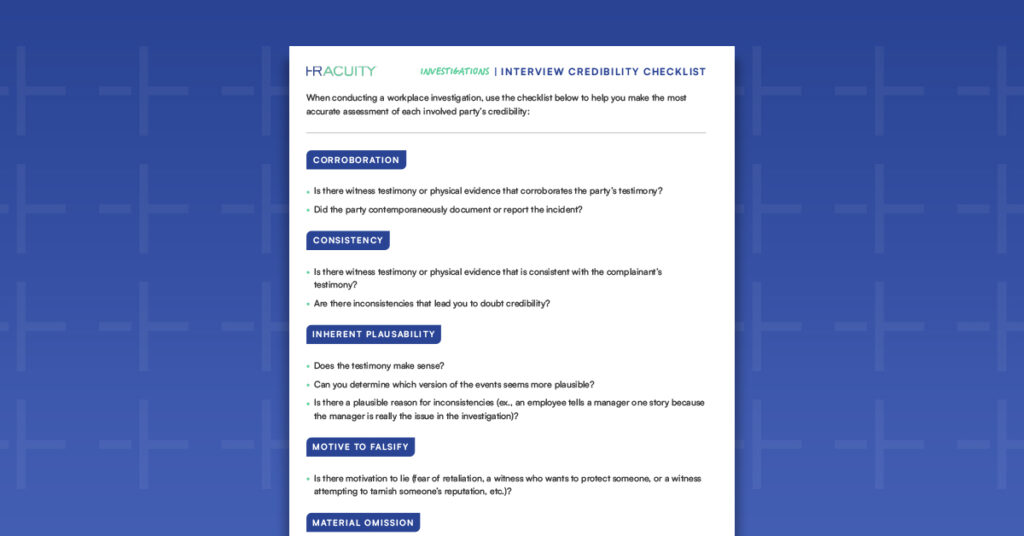Credibility isn’t about who seems more believable. It’s about patterns, documentation and thoughtful evaluation across five core factors: Corroboration, consistency, plausibility, motive to falsify and omission.
This guide breaks down HR Acuity’s Interview Credibility Checklist into practical, real-world tools ER and HR leaders can apply during investigations. This framework will help you spot signals and document findings with professional rigor, not instinct.
Corroboration: What Independent Facts Back This Up?
Ask:
-
Do documents or digital trails (emails, chat logs, calendars) support key parts of the story?
-
Is there another person’s account that aligns with this version?
-
Was anything reported contemporaneously (not retroactively)?
💡 Best practice: Cross-reference timelines and evidence to strengthen your assessment.
Consistency: Does This Story Hold Over Time and Across Sources?
Ask:
-
Is the core account the same across retellings?
-
Does the tone, language or level of detail change meaningfully?
-
Does it align with other testimony or surface discrepancies?
🛠 Investigator note: Some variation is normal—trauma, fear or time can all impact the ability to recall. However, you should flag unexplained or critical inconsistencies.
Inherent Plausibility: Does This Story Make Sense in Context?
Ask:
-
Are the actions and timing logistically possible?
-
Does it reflect how people typically behave in this setting?
-
Are there gaps that make the sequence confusing or unlikely?
⚠️ Use with caution: What seems implausible to you might be shaped by unconscious bias. Use plausibility to raise questions, not to dismiss.
Motive to Falsify: Is There a Reason to Distort the Truth?
Ask:
-
Could the individual benefit by changing the story (to avoid consequences, protect someone or gain influence)?
-
Do interpersonal dynamics reveal loyalty, resentment or fear that could shape testimony?
-
Are motivations consistent with other known facts?
🧩 Tip: Motive isn’t always malicious—self-preservation, fear of retaliation or peer pressure are common.
Material Omission: What Wasn’t Said That Should’ve Been?
Ask:
-
Were obvious details left out without explanation?
-
Did the person avoid answering directly, even when prompted?
-
Are there “missing links” others mentioned, but this person didn’t?
📋 Credibility cue: Omission becomes a red flag when someone had the opportunity to disclose and didn’t—especially if that involves central facts.
Caution Areas: Where Credibility Assessments Often Go Wrong
🚫 Demeanor Bias: Nervousness, lack of eye contact or emotional expression don’t necessarily equate to dishonesty. Cultural background, neurodivergence or stress often explain delivery.
🚫 Memory Discrepancies: Imperfect recall is normal, especially in stressful or emotionally charged situations. Don’t confuse fuzzy memory with falsehood.
How to Put This Checklist into Action
🔍 During Interviews: Structure your questions around these five factors. Don’t rely on generic prompts—target what you need to evaluate.
📝 In Your Notes: Use headings or tags by factor (“corroboration,” “motive”) so your final analysis isn’t just chronological, but aligned with evidence.
📊 In Your Findings: Summarize each factor clearly in your report. Avoid “overall gut feel”—focus on how each area informs your credibility determination.
FAQs: Investigation Interview Credibility Checklist
Q: What’s the difference between inconsistency and dishonesty?
Inconsistency means details don’t line up. Dishonesty means there’s intent to mislead. Not all inconsistencies signal deception—stress, trauma, fear of retaliation or time gaps can all impact memory. Look for material inconsistencies that change the story’s meaning or outcomes. Then assess them using corroboration, motive and plausibility.
Q: Can demeanor ever be used to assess credibility?
No. Nervousness, confidence or body language vary widely and are shaped by culture, neurodivergence and stress. They’re not indicators of truthfulness and should never drive a credibility conclusion.
Q: How do I document credibility without sounding biased?
Structure your notes and findings by the five factors. Use quotes, reference evidence and explain your rationale. Avoid statements like “they were believable” and focus on what supported or weakened credibility.
Q: Should I tell the person I’m assessing their credibility?
No. Your role is to gather facts, not to warn about scoring. Keep interviews neutral, open-ended and focused on the situation—not on the individual’s perceived truthfulness.
Q: What if multiple people tell conflicting stories, but all seem credible?
Use the checklist. Break each version down by the five factors. Compare the strength of evidence, the consistency of details and the presence of motive or omission. You’re not choosing sides—you’re evaluating credibility based on structure.
Disclaimer
This guide is a professional support resource based on HR Acuity’s Interview Credibility Checklist (2024). It is not a substitute for legal guidance or organizational policy.




